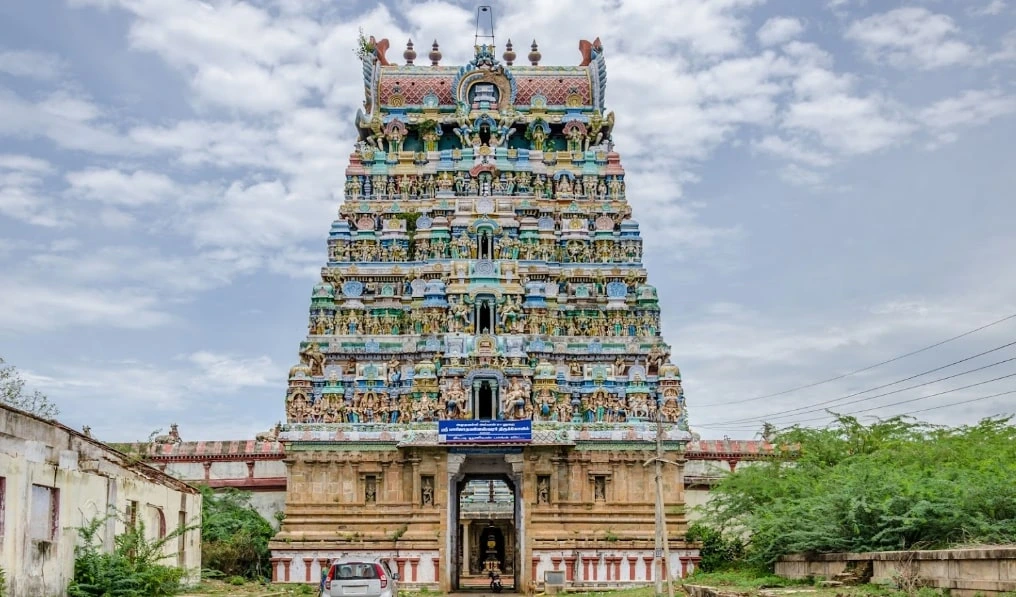



Blogs What to Expect on Your First Visit to Tiruvarur Temple – A Complete Guide

Tiruvarur is renowned for its historic and sacred temples, with the most notable ones being deeply rooted in Tamil Nadu's rich spiritual and architectural heritage. Here are some of the famous temples in and around Tiruvarur:
Deity: Lord Shiva (as Thyagaraja)
Significance: This is the most famous temple in Tiruvarur, known for its sprawling complex and intricate Dravidian architecture. It is home to one of the largest temple chariots (rathas) in Tamil Nadu, used during the grand Therottam festival.
Special Features: The temple complex includes several smaller shrines, the famous Kamalalayam Tank, and is dedicated to the worship of Shiva in his dancing form.
Deity:
The temple is dedicated to Lord Shiva, worshipped as Thyagaraja, a form of Shiva in his cosmic dancer (Somaskanda) aspect.
Architectural Style:
Built in the traditional Dravidian architecture, the temple is one of the largest in India, with towering gopurams (gateway towers) and intricate stone carvings.
Therottam (Chariot Festival):
The annual Therottam Festival is famous for featuring the largest temple chariot in Tamil Nadu. Thousands of devotees participate in pulling the enormous wooden chariot through the streets.
Kamalalayam Tank:
The temple complex includes the massive Kamalalayam Temple Tank, one of the largest temple tanks in the state, symbolizing purity and divinity.
Musical Heritage:
The temple is closely associated with Carnatic music, especially due to its link with the composer Saint Thyagaraja, one of the Carnatic Music Trinity.
Complex Layout:
The temple has multiple shrines, the main one dedicated to Thyagaraja, and also features elaborate halls like the 1000-pillared hall, adding to its grandeur.
Historical Significance:
The temple has been patronized by various South Indian dynasties, including the Cholas, who were instrumental in its expansion during their reign.
Temple Timings:
It is open daily for devotees, with major poojas and rituals performed throughout the day, especially during festival seasons.
Deity: Lord Krishna (as Rajagopalaswamy)
Location: 28 km from Tiruvarur, in Mannargudi.
Significance: This Vaishnavite temple is one of the largest and most opulent in Tamil Nadu. Its massive size and detailed carvings attract devotees and tourists alike.
Special Features: Known for its beautiful Rajagopuram (main tower) and the divine image of Lord Krishna.
Deity:
The temple is dedicated to Lord Krishna, worshipped here as Rajagopalaswamy, a royal form of Krishna depicted as a cowherd holding a whip and flute.
Temple Size:
Known for its massive size, the temple complex spans over 23 acres, making it one of the largest temple complexes in Tamil Nadu.
Architecture:
The temple showcases stunning Dravidian architecture with elaborate stone carvings, a majestic Rajagopuram (entrance tower) that stands 192 feet tall, and beautifully sculpted pillars.
Sacred Tank:
The temple houses the Haridra Nadhi, a large temple tank that adds to the serene atmosphere of the complex, used for various temple rituals and festivals.
Festivals:
The Brahmotsavam Festival, held annually, is one of the temple’s most important events, drawing thousands of devotees. The celebrations include processions of Lord Rajagopalaswamy on beautifully decorated temple chariots.
Historical Significance:
The temple was originally built by the Chola dynasty and expanded by the Vijayanagara rulers, highlighting its long-standing religious importance and royal patronage.
Temple Offerings:
Devotees offer prayers and perform special poojas for prosperity and blessings, with many offering butter, garlands, and traditional items to Lord Rajagopalaswamy.
Nicknamed Dakshina Dwarka:
The temple is referred to as the "Dakshina Dwarka", meaning the Dwarka of the South, due to its deep association with Lord Krishna and the temple’s resemblance to the Dwarka temple in Gujarat.
Deity: Lord Murugan
Significance: A historic temple situated near Tiruvarur, it is devoted to Lord Murugan, the Tamil god of war and victory. It is a popular destination for devotees of Murugan in the region.
Special Features: The temple is located in a scenic setting, enhancing its spiritual atmosphere.
Deity:
The temple is dedicated to Lord Murugan, the Tamil god of war and victory, who is highly revered across Tamil Nadu.
Location:
The temple is situated in Engan, a village near Tiruvarur, and is surrounded by serene natural landscapes, enhancing its spiritual ambiance.
Historical Significance:
The temple is believed to be several centuries old and is considered an important pilgrimage site for Murugan devotees in the region.
Unique Feature:
The temple is famous for the unique posture of the Murugan deity. Lord Murugan here is depicted with his head slightly tilted to the left, which is considered rare and adds to the temple's significance.
Architecture:
The temple showcases traditional Dravidian architecture, with a modest structure but beautiful carvings and designs that reflect the local temple-building style.
Festivals:
The temple celebrates Thai Poosam and Karthigai Deepam with great fervor. Devotees flock to the temple during these festivals, which are marked by special poojas, processions, and rituals dedicated to Lord Murugan.
Pilgrimage Importance:
The temple holds spiritual significance for devotees seeking courage, strength, and success in their endeavors, as Murugan is worshipped as the protector and bringer of victory.
Serene Environment:
Set in a peaceful rural environment, the temple is an ideal place for devotees and visitors seeking a calm and spiritually uplifting experience.
Deity: Lord Rama
Significance: This temple is unique because it celebrates Lord Rama, and its architecture reflects the styles of the early Tamil dynasties.
Special Features: A lesser-known but serene place for those seeking a quiet pilgrimage experience.
Deity:
The temple is dedicated to Lord Rama, worshipped here as Kothanda Ramar. It also includes a shrine for Perungarudeswarar, a form of Lord Shiva.
Location:
The temple is located in the Tiruvarur district and is known for being a serene and spiritually significant site for both Shaivite and Vaishnavite devotees.
Architecture:
The temple features traditional Dravidian architecture with simple yet elegant designs, reflective of early Tamil temple construction.
Unique Aspect:
It is unusual to find temples dedicated to both Lord Rama and Lord Shiva in one complex, making this temple an interesting site for devotees of both deities.
Perungarudeswarar Shrine:
The Shiva shrine is an important part of the temple, attracting Shaivite devotees who come to offer prayers to Perungarudeswarar (Shiva) for blessings of health and prosperity.
Festivals:
Major festivals like Rama Navami (celebrating the birth of Lord Rama) and Mahashivaratri are observed with great devotion, attracting devotees from nearby areas.
Temple Atmosphere:
The temple’s tranquil setting and lesser crowds make it an ideal place for devotees seeking a peaceful environment for worship and meditation.
Historical Significance:
The temple has historical roots tracing back to early Tamil dynasties, making it an important cultural and religious site in the region.
Deity: Lord Shiva (as Paalaivananathar)
Location: About 26 km from Tiruvarur.
Significance: This ancient Shiva temple is another important pilgrimage site, known for its historical and religious importance in the region.
Deity:
The temple is dedicated to Lord Shiva, worshipped here as Paalaivananathar (the Lord of the forest), and Goddess Parvati as Lokanayaki.
Location:
It is situated in Thiruthuraipoondi, about 26 km from Tiruvarur, in the Tiruvarur district of Tamil Nadu.
Historical Significance:
This is an ancient temple with historical roots dating back to the Chola period, making it an important religious and architectural site in the region. It has been mentioned in the hymns of the Nayanmars, particularly Appar and Sundarar.
Architecture:
The temple showcases classic Dravidian architecture, with intricate carvings, tall gopurams (towers), and beautifully sculpted stone pillars. Its traditional style is a testimony to the craftsmanship of ancient Tamil builders.
Sacred Teertham:
The temple has a holy tank, known as Gnana Theertham, where devotees take a ritual bath before offering prayers, as it is believed to have cleansing and healing powers.
Festivals:
The temple celebrates Maha Shivaratri and Pradosham with great devotion, attracting many devotees during these occasions for special poojas and rituals.
Spiritual Significance:
Paalaivananathar is believed to bless devotees with good health and prosperity. Many people visit the temple to seek relief from illnesses and hardships.
Tranquil Setting:
The temple is surrounded by nature, giving it a peaceful and serene atmosphere, ideal for meditation and spiritual reflection.
The Paalaivananathar Temple is an important pilgrimage site for Shiva devotees and a significant part of Tamil Nadu’s religious and cultural heritage.
These temples make Tiruvarur a key spiritual destination in Tamil Nadu, drawing devotees from across India for their architectural beauty and religious significance.